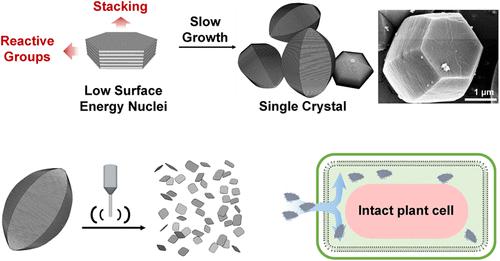当前位置:
X-MOL 学术
›
J. Am. Chem. Soc.
›
论文详情
Our official English website, www.x-mol.net, welcomes your feedback! (Note: you will need to create a separate account there.)
Single-Crystal 2D Covalent Organic Frameworks for Plant Biotechnology
Journal of the American Chemical Society ( IF 15.0 ) Pub Date : 2023-05-25 , DOI: 10.1021/jacs.3c01783 Song Wang 1 , Vaishnavi Amarr Reddy 2 , Mervin Chun-Yi Ang 1 , Jianqiao Cui 3 , Duc Thinh Khong 1 , Yangyang Han 1 , Suh In Loh 1 , Raju Cheerlavancha 1 , Gajendra Pratap Singh 1 , Sarojam Rajani 2 , Michael S Strano 1, 3
Journal of the American Chemical Society ( IF 15.0 ) Pub Date : 2023-05-25 , DOI: 10.1021/jacs.3c01783 Song Wang 1 , Vaishnavi Amarr Reddy 2 , Mervin Chun-Yi Ang 1 , Jianqiao Cui 3 , Duc Thinh Khong 1 , Yangyang Han 1 , Suh In Loh 1 , Raju Cheerlavancha 1 , Gajendra Pratap Singh 1 , Sarojam Rajani 2 , Michael S Strano 1, 3
Affiliation

|
Molecules chemically synthesized as periodic two-dimensional (2D) frameworks via covalent bonds can form some of the highest-surface area and -charge density particles possible. There is significant potential for applications such as nanocarriers in life sciences if biocompatibility can be achieved; however, significant synthetic challenges remain in avoiding kinetic traps from disordered linking during 2D polymerization of compatible monomers, resulting in isotropic polycrystals without a long-range order. Here, we establish thermodynamic control over dynamic control on the 2D polymerization process of biocompatible imine monomers by minimizing the surface energy of nuclei. As a result, polycrystal, mesocrystal, and single-crystal 2D covalent organic frameworks (COFs) are obtained. We achieve COF single crystals by exfoliation and minification methods, forming high-surface area nanoflakes that can be dispersed in aqueous medium with biocompatible cationic polymers. We find that these 2D COF nanoflakes with high surface area are excellent plant cell nanocarriers that can load bioactive cargos, such as the plant hormone abscisic acid (ABA) via electrostatic attraction, and deliver them into the cytoplasm of intact living plants, traversing through the cell wall and cell membrane due to their 2D geometry. This synthetic route to high-surface area COF nanoflakes has promise for life science applications including plant biotechnology.
中文翻译:

用于植物生物技术的单晶二维共价有机框架
通过共价键化学合成为周期性二维 (2D) 骨架的分子可以形成一些可能具有最高表面积和电荷密度的粒子。如果能够实现生物相容性,则在生命科学中的纳米载体等应用具有巨大潜力;然而,在兼容单体的二维聚合过程中避免无序连接的动力学陷阱仍然存在重大的合成挑战,从而导致各向同性多晶没有长程有序。在这里,我们通过最小化原子核的表面能,建立了对生物相容性亚胺单体二维聚合过程动态控制的热力学控制。结果,获得了多晶、介晶和单晶 2D 共价有机骨架 (COF)。我们通过剥离和微细化方法获得 COF 单晶,形成高表面积纳米薄片,可以与生物相容性阳离子聚合物一起分散在水性介质中。我们发现这些具有高表面积的 2D COF 纳米薄片是出色的植物细胞纳米载体,可以通过静电吸引负载生物活性物质,例如植物激素脱落酸 (ABA),并将它们输送到完整活植物的细胞质中,穿过细胞壁和细胞膜由于其 2D 几何形状。这种高表面积 COF 纳米薄片的合成路线有望用于包括植物生物技术在内的生命科学应用。我们发现这些具有高表面积的 2D COF 纳米薄片是出色的植物细胞纳米载体,可以通过静电吸引负载生物活性物质,例如植物激素脱落酸 (ABA),并将它们输送到完整活植物的细胞质中,穿过细胞壁和细胞膜由于其 2D 几何形状。这种高表面积 COF 纳米薄片的合成路线有望用于包括植物生物技术在内的生命科学应用。我们发现这些具有高表面积的 2D COF 纳米薄片是出色的植物细胞纳米载体,可以通过静电吸引负载生物活性物质,例如植物激素脱落酸 (ABA),并将它们输送到完整活植物的细胞质中,穿过细胞壁和细胞膜由于其 2D 几何形状。这种高表面积 COF 纳米薄片的合成路线有望用于包括植物生物技术在内的生命科学应用。
更新日期:2023-05-25
中文翻译:

用于植物生物技术的单晶二维共价有机框架
通过共价键化学合成为周期性二维 (2D) 骨架的分子可以形成一些可能具有最高表面积和电荷密度的粒子。如果能够实现生物相容性,则在生命科学中的纳米载体等应用具有巨大潜力;然而,在兼容单体的二维聚合过程中避免无序连接的动力学陷阱仍然存在重大的合成挑战,从而导致各向同性多晶没有长程有序。在这里,我们通过最小化原子核的表面能,建立了对生物相容性亚胺单体二维聚合过程动态控制的热力学控制。结果,获得了多晶、介晶和单晶 2D 共价有机骨架 (COF)。我们通过剥离和微细化方法获得 COF 单晶,形成高表面积纳米薄片,可以与生物相容性阳离子聚合物一起分散在水性介质中。我们发现这些具有高表面积的 2D COF 纳米薄片是出色的植物细胞纳米载体,可以通过静电吸引负载生物活性物质,例如植物激素脱落酸 (ABA),并将它们输送到完整活植物的细胞质中,穿过细胞壁和细胞膜由于其 2D 几何形状。这种高表面积 COF 纳米薄片的合成路线有望用于包括植物生物技术在内的生命科学应用。我们发现这些具有高表面积的 2D COF 纳米薄片是出色的植物细胞纳米载体,可以通过静电吸引负载生物活性物质,例如植物激素脱落酸 (ABA),并将它们输送到完整活植物的细胞质中,穿过细胞壁和细胞膜由于其 2D 几何形状。这种高表面积 COF 纳米薄片的合成路线有望用于包括植物生物技术在内的生命科学应用。我们发现这些具有高表面积的 2D COF 纳米薄片是出色的植物细胞纳米载体,可以通过静电吸引负载生物活性物质,例如植物激素脱落酸 (ABA),并将它们输送到完整活植物的细胞质中,穿过细胞壁和细胞膜由于其 2D 几何形状。这种高表面积 COF 纳米薄片的合成路线有望用于包括植物生物技术在内的生命科学应用。



























 京公网安备 11010802027423号
京公网安备 11010802027423号